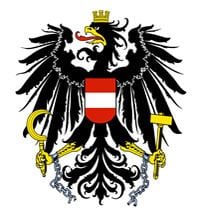 | ||
The Austrian Federal Government (German: Österreichische Bundesregierung) is a collective body that exercises executive power in the Republic of Austria. It is composed of the Chancellor, who is leader of the government, the Vice-Chancellor, and senior ministers. The President and the Government together form the executive branch of Austria.
Contents
Nomination
Since the 1929 reform of the Austrian Constitution, all members of the Federal Government are appointed by the Austrian Federal President (according to Article 70 of the Bundes-Verfassungsgesetz (B-VG)[1]), who nevertheless has to seek a consensus with the National Council parliament, since a vote of no confidence would immediately enforce their dismissal. In practical terms usually the leader of the strongest political party, who ran as "chancellor candidate" in the parliamentary election, is asked to become Federal Chancellor; although there have been exceptions in the past. The nominations of the ministers takes place at the suggestion of the Chancellor, though the President is permitted to withhold his or her approval. Likewise, the President may dismiss the Chancellor and/or the whole government at any time. However, a new government must be formed by the parties that control parliament.
Functioning
The government is convened for frequently scheduled meetings. When formally convened as such, the government is termed the Council of Ministers (German: Ministerrat), which is equivalent to the word "cabinet". The Chancellor presides over cabinet meetings as first among equals without decisional authority, regardless of his right of proposal concerning the appointment of the government's members by the President. The cabinet adopts resolutions in the presence of at least half of its members and, according to the ruling of the Austrian Constitutional Court, unanimously – in particular the introduction of bills to the National Council. Each federal minister is also responsible for his or her own ministry, and may be supported by one or more state secretaries (junior ministers), who also participate in the cabinet's meetings. State secretaries are not considered members of the government, and have no right to vote during cabinet meetings.
Current government
The incumbent government of Austria is a grand coalition government formed by the left-wing Social Democratic Party of Austria (SPÖ) and the right-wing Austrian People's Party (ÖVP). It was appointed on 18 May 2016 by outgoing President Heinz Fischer (SPÖ) upon the resignation of the former Chancellor Werner Faymann after disappointing results of his party in the 2016 Austrian presidential election. Most of the ministers kept their job, however, some decided to step down or were replaced.
First Republic
After the dissolution of the Austro-Hungarian Monarchy, the provisional national assembly of German Austria on 30 October 1918 elected a State Council (Staatsrat) executive, which itself appointed a state government with the Social Democratic politician Karl Renner as head of the State Chancellery. The Renner ministry was composed of representatives of the three main political parties—Social Democrats, the Christian Social Party (CS) and German Nationalists (Greater Germans)—according to the Proporz doctrine. As acting executive body it remained in office until the Constitutional Assembly of the Austrian First Republic on 15 March 1919 elected Renner's second cabinet, a coalition government of Social Democratic and Christian Social ministers.
State Chancellor Renner had signed the Treaty of Saint-Germain-en-Laye, whereafter his cabinet retired en bloc. Re-elected by the Constitutional Assembly on 17 October 1919, his third cabinet finally was overturned with the break-up of the SPÖ-CS coalition on 7 July 1920. Renner was succeeded by the Christian Social politician Michael Mayr, who with the commencement of the Austria Constitution on 10 November 1920 became first Federal Chancellor of Austria. Mayr and his successors proceeded with the support of the Christian Social Party and the Greater German nationalists, while the Social Democrats remained in opposition.
From 5 March 1933 onwards, the Christian Social chancellor Engelbert Dollfuß kept on ruling by suppression of the National Council parliament. In the course of the Austrian Civil War he brought down the opposition and on 1 May 1934 implemented the authoritarian Federal State of Austria. All parties were banned, except for the Fatherland's Front supporting Dollfuß' Austrofascist government. The Federal Government discontinued with the Anschluss incorporation of Austria into Nazi Germany on 13 March 1938.
Second Republic
On 27 April 1945 a provisional Austrian national unity government, again under a State Chancellor Karl Renner, declared the Anschluss null and void. It prepared the The elections to the Austrian National Council held on 25 November. On 20 December 1945, the Austrian Constitution was officially re-enacted, with ÖVP founder Leopold Figl forming the first post-war Federal Government.
List of cabinets since 1945:
